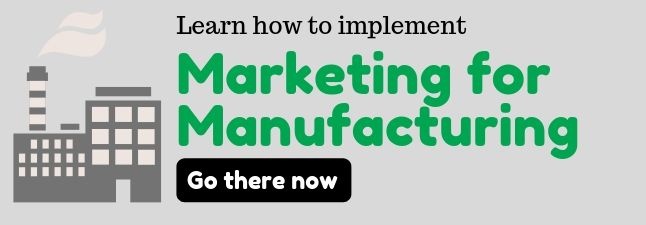Posted by Todd Hockenberry ● Apr 01, 2024
Content Marketing for Manufacturers
Why is content marketing particularly important for manufacturers? And, why is content marketing more important in a world awash in AI-generated content?
In my book Inbound Organization, Adam Robinson explains it this way, “Leadership and being seen as a leader in anything typically extends to trust and being seen as a leader in other aspects of your business. If we're seen as a leader in content, the perception is most likely that we're a leader in the services and the technology that we provide.”

Peter Drucker once said that “the purpose of a business is to create and keep a customer.”
Today, companies do that by building trust and being a leader in their industry.
And content is the primary tool used to attract and engage buyers today. We know:
- Virtually all consumers use online media when researching products and services
- Virtually all B2B purchases start with an Internet search
- Virtually all buyers engage in online information consumption and education
- By a factor of 3 to 1, B2B buyers say that gathering information online on their own is superior to interacting with a sales representative - these buyers avoid talking to you
- A majority of B2B buyers explicitly indicate that they do not want to interact with a sales representative as their primary source of research
- 74% of sales go to the first company that was helpful
And what attracts, engages, and builds trust by helping? Content marketing, of course.
Is content marketing a strategy you must have to succeed in selling in B2B markets today?
Yes, it is.
Why Manufacturers Need a Content Marketing Strategy
Research says 74% buy from the first company that was helpful, and if many prospects start their buyer journey by searching online, then your content is the first impression and representative of your company and brand.
There is a statistic out there that says that the buying process is 70% over before buyers want to talk to a salesperson. Here is a story that illustrates the truth of that stat.
One of our clients is a company in the Midwest that manufactures and distributes capital equipment for the tube fabrication industry. I recently visited their open house with customers from all over the country. They had just launched a new laser cutting line and were showing it off to existing customers.
A gentleman, who happened to be the President of a large existing customer of my client, walked up to the owner and said, “We’ve looked at a bunch of laser manufacturers and have narrowed it down to two companies, you and another. We eliminated 3 others based on features, price, and reputation by reviewing thecontentwe could find online. Can we talk about a specific proposal?”
This EXISTING CUSTOMER did not talk to a salesperson of my client for this $500k+ purchase.
They ELIMINATED three other vendors using online searches and other available digital information.
They only reached out to my client when they were ready to get into the details and specify a machine.
So, was this sales process 70% over? In this case, I say yes it was.
- Is it always 70% over before they call a salesperson? No.
- Does the 70% number represent an average or ballpark? Yes, and imagine what this number will be in 5 years.
- Does this 70% number go down if a company is proactively reaching out to target prospects? Maybe, but you better be the one being the most helpful in your marketing or your outbound, promotional efforts just may not work.
Are you using content to engage prospects BEFORE they reach out to you?Inbound Marketingis a well-established methodology and framework for creating, optimizing, sharing, and using content to engage with a market before they pick up the phone and call. The core principle of Inbound is to attract instead of interrupt. Be where your best prospects are looking for information as they educate themselves about their situations and possible paths to improvement.
Marketing, sales, and even service should be focused on implementing a help strategy using Inbound Marketing ideas and methodologies.
Put yourself in your prospect's and customer’s shoes and deliver great content and an experience that helps them improve. That is what customers require today.
And, like all good inbound practices, content marketing isn’t just a guessing game. Analysis and measurement should be built into your content marketing strategy. In the example above a prospect told our client that their content played a role in their decision to reach out, but that kind of direct confirmation isn’t normal. Most of the time we rely on tracking software to generate data we can analyze to see what moves the needle.
When it comes to data tracking, there are a lot of options out there. From Google Analytics to built-in features on social media platforms, there are a lot of ways to find and manipulate the data around your content.
What is Content?
Simply put, content is your expertise shared.
There are in general a few key types of content:
- Product - features, specifications, just the facts ma'am
- Application - how, when, and where a product or service is used, includes industry or usage-focused information
- Solution - the answer to a question or the information that takes the readers from the problem they have to the answer they seek
- Persona - focused information about a particular person/role/position and how to make their life better, easier, faster, or other outcomes-based information
- Insights - analysis of industry, strategy, data, or technology trends to name a few, any content that delivers insights that help the reader make sense of their world
Content is your expertise communicated in a way that your audience understands, and can absorb, and that helps them improve their situation, ideally by moving them to action.
Content Formats Include:
- Text - ebooks, blog posts, website pages, whitepapers
- Video - huge for just about everyone right now
- Images, drawings, photos, charts
- Webinars
- Infographics
- Lists, guides, step-by-step instructions
- Selectors - answer a series of questions to narrow down to the best solution
- Presentations, speeches, and conversations
- And I am sure many more...
So, content is any information relevant to your audience that you format and share.
What Do You Do with Content Once You Have It?
There are three places to distribute and promote content:
- Owned Media - share content
Owned media includes your website, sales literature, social media channels, email, trade show, sales team, lobby, and anything else that you directly control. Many companies make the mistake of jumping into paid media before they maximize their owned media.
One way to think about owned media is to consider where you could promote a case study, to give just one example. Think of all the places you can share this case study where people you want to influence would find it - the target audience could be prospects, customers, partners, vendors, connectors, or anyone else you think might be interested in this particular piece of content.
Maximize your owned channels first, and take full advantage of what you already have before you move on to paid and earned media.
- Paid Media - promote content
Paid media is just that, access to an audience that you pay for. Google Adwords and pay-per-click ads, re-targeting ads, trade journal ads, buying lists, banner ads, sponsored content, and advertorials are just a few of the many paid media options.
Targeting and ROI are the keys to paid ads. Is my target audience, as narrowly defined as possible, paying attention to this paid media channel? And if we invest do we see a measurable return? The measured return might be awareness, leads, or sales. You need clear goals for paid media and a way to measure its effect.
Generally, for manufacturing, vanity metrics like 'impressions' sound good but often have little to no bearing on results that executives want like leads and sales. Make sure you have solid reasons to pay for media beyond 'the owner likes to see our full-page ads in the trade journal.'
- Earned Media - distribute content
Earned media is publicity and content distribution received by promoting your content to others.
You earn media attention through shares, mentions, likes, re-posts, reviews, comments, forwarding, and other actions taken by publishers, influencers, bloggers, and other people who connect with your target audience.
How to Get More Content?
Insource it
The single best source of content is, of course, your people. Marketing is often the first place people go to get content, but sales should be right at the top of the list. Why? Because they hear the questions all day long that come from prospects and customers. These questions are the foundation of your content development strategy. Service and support also have a large role in content development, and in my experience, very few manufacturing companies use them in this capacity.
Using content to maintain close engagement after the sales and to extend customer relationships is one of the biggest areas for improvement we see for manufacturing companies.
Outsource it
Hiring a contract writer or marketing company to write for you is a possibility. What they may have in terms of experience writing needs to balance with what they don't know about your business.
The risk of outsourcing your content writing is that it will be too general and not authentic or, frankly, relevant. Some marketing agencies can write good content for manufacturing companies. We write a lot for our customers, but we have also been in the manufacturing space for 15 years as an agency, and I have almost 30 years of experience in industrial markets.
In our experience, the ideal situation for a manufacturing company that wants to outsource is to bring in an expert who knows what to write for the target audience and how best to position and promote that content with the meat of the content - the expertise - from the manufacturer.
Share/Aggregate/Analyze
Another valid way of creating content is to take the piles that relate to your target audience and help them make sense of it by sorting it out and sharing the best and most relevant with them. Becoming a source of clarity for your audience can be an important function when it comes to content.
Guests
Asking experts who relate to your target audience and can bring helpful content is a win-win-win scenario. You win because you get to help your audience without creating content. The guest wins because they now get to extend their reach and grow their audience. Your audience wins because they get a different perspective and valuable insight.
Who in Your Company Should be Using Content?
Everyone. Yes, everyone. Sales and marketing are obvious but what about everyone else?
Service/Support - educating customers and helping them with problems is a core principle of a successful business and content is the primary means for service/support to deliver it.
Engineering/Design/Product Development - guidelines, specifications, checklists, drawings, materials lists, process steps - technical people live in content all day and need to see it as a way to make connections with customers and prospects.
Legal - think about terms and conditions or service agreements and the annoyance of signing or agreeing to them when no one reads them, there has to be a better way.
Accounting - can you share tips on how to finance your product? Maybe tax-saving ideas relating to your service.
HR - promote how awesome your company is to work for - in an age of competition for the best workers don't let the content on glassdoor.com be the only content prospective employees see about you. And by the way, if your website stinks that sends a horrible message to potential employees (and yes, they all check it before coming to talk to you).
Leadership - referrals, connections, recommendations - Smart leaders use content to improve their communication and engagement with key stakeholders.
Facilities people - an owned media platform for sure, do you ever have anyone visit?
Janitor - are the floors clean, the lawn mowed, and the paint fresh? Your brand is conveyed by your physical location. So maybe a stretch on the janitor using content, but you see my point.
What Do You Get from Content
So, what do you get from all of this content?
- Get found online
- You get to engage people earlier in the buyer journey
- You build trust and start relationships right by being helpful
- You drive engagement longer and deeper into the buying process
- You deliver a better customer experience
- And you certainly should get more leads and sales
Trust is the key factor today in an age of AI-generated content. Whom can you trust? Answer that question with your content and you have a chance to gain the trust of targeted buyers and earn the chance to win the sale.
Call us today if you want to learn more about using content as part of your manufacturing marketing strategy.
Sources:
97% of consumers now use online media when researching products and services in their local market -http://www.prnewswire.com/news-releases/nearly-all-consumers-97-now-use-online-media-to-shop-locally-according-to-biakelsey-and-constat-87221242.html
93% of all B2B purchases start with an Internet search - http://blog.marketo.com/2012/03/b2b-marketing-in-a-downturn-part-1-lead-generation-and-nurture.html
84% of buyers engage in online information consumption and education -https://www.thinkwithgoogle.com/collections/zero-moment-truth.html
By a factor of 3 to 1, B2B buyers say that gathering information online on their own is superior to interacting with a sales representative - http://blogs.forrester.com/lori_wizdo/15-07-28-are_your_reps_butchering_your_early_stage_leads
59% of B2B buyers explicitly indicate that they do not want to interact with a sales representative as their primary source of research -http://blogs.forrester.com/lori_wizdo/15-07-28-are_your_reps_butchering_your_early_stage_leads
74% of sales go to the first company that was helpful -https://www.salesforce.com/blog/2016/04/b2b-buyers-change-social-sell-on-linkedin.html
Topics: Marketing, Manufacturing, Content






